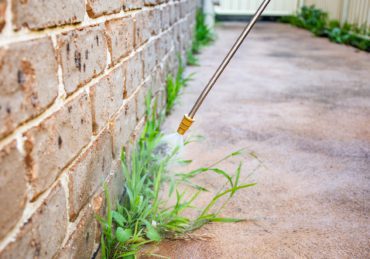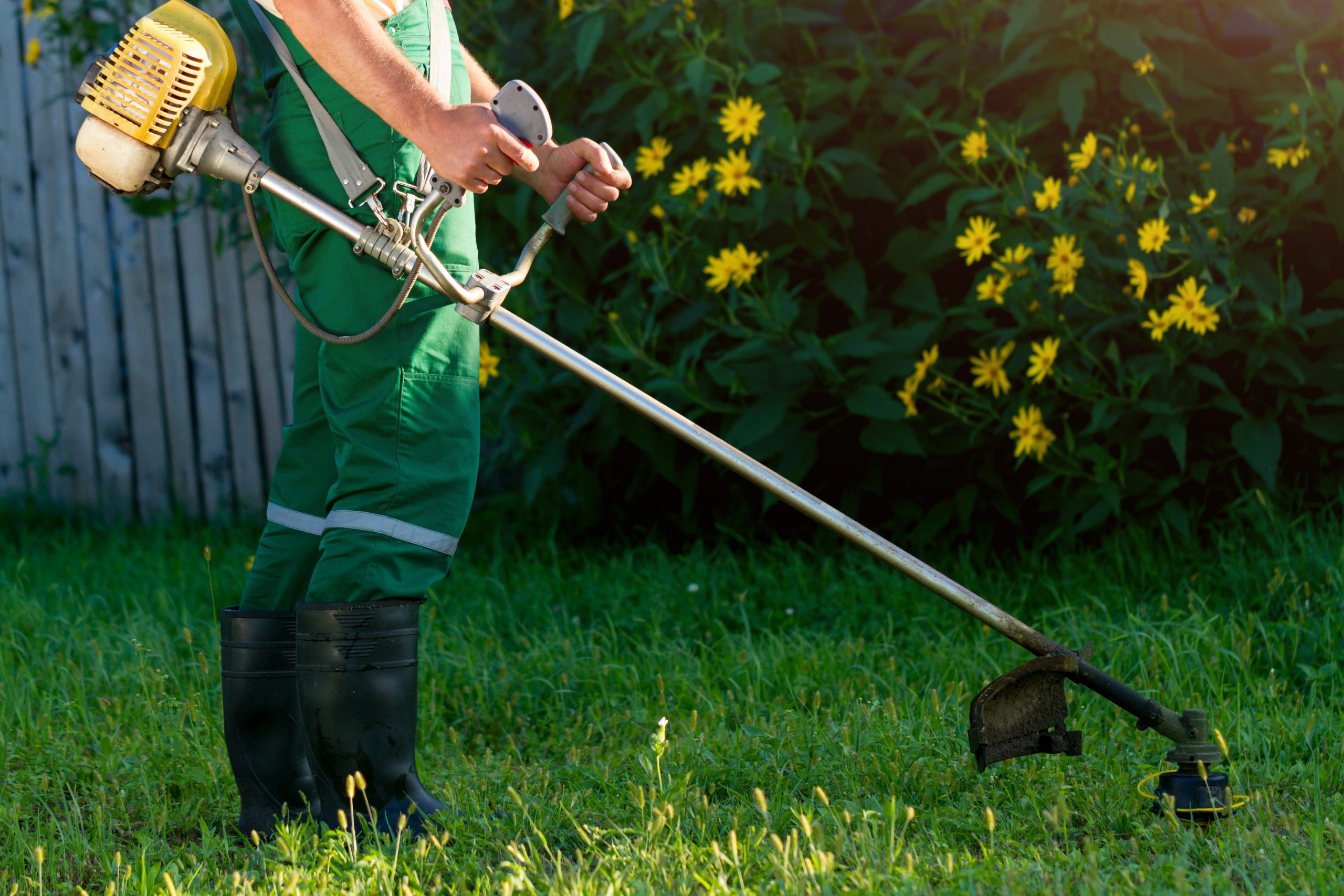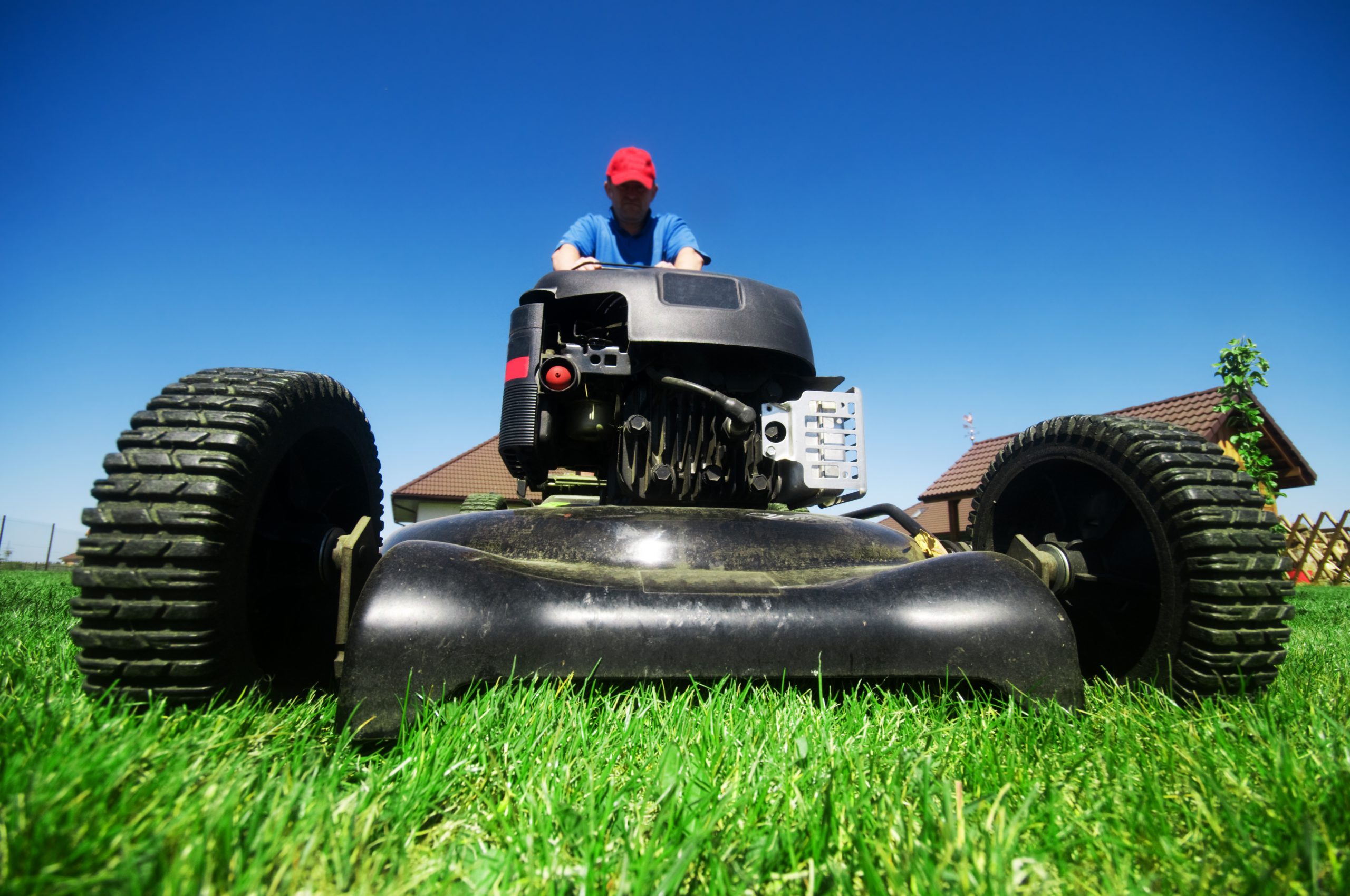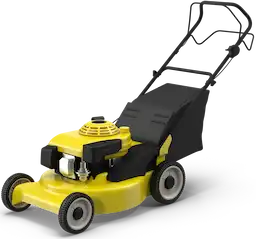To cut overgrown grass effectively, begin by evaluating the lawn and selecting a day with dry weather. Use a sharp lawn mower set to its highest cutting height to reduce stress on the grass. Follow the one-third rule; never remove more than one-third of the blade length in a single cut. Consider employing a double-cut technique if the grass is particularly stubborn. Manage clippings appropriately, either bagging them or mulching to nourish the soil. Allow the grass time to recover between cuts for ideal health. For further insights on maintaining a healthy lawn, investigate additional care techniques.
Best Time to Mow an Overgrown Lawn
Choosing the right weather conditions is essential when mowing an overgrown lawn. A sunny, warm day with dry grass minimizes the risk of bacterial growth and disease.
Furthermore, proper preparation before the first cut guarantees a healthier lawn and ideal cutting results.
Consider Weather Conditions
When is the ideal time to tackle overgrown grass? Weather conditions play an important role in determining the best time to mow. Sunny, warm days are preferable, as mowing when the grass is dry minimizes the risk of introducing bacteria and diseases that thrive in damp conditions.
For the initial cut, it’s important to reduce the grass height to about 50% of its current level. This gradual approach is crucial to prevent shock to the lawn, facilitating a healthier recovery.
Avoid cutting more than one-third of the grass height in a single session to reduce stress on the turf, which can lead to yellowing and slow regeneration.
For lawns that are extremely overgrown, multiple mowing sessions may be required over the course of a month. Allowing 2-4 days of recovery between cuts will promote healthy growth and minimize damage to the grass.
Easily hire the best lawn & landscape pros working in your neighborhood.
Preparing Your Lawn for the First Cut
A successful first cut of overgrown grass hinges on proper preparation and timing. Ideal conditions for mowing include sunny, warm days when the grass is dry, minimizing the risk of disease and ensuring a clean cut.
Before the initial mowing, utilize a line trimmer to reduce grass height by approximately 50%. This step simplifies the mowing process and prevents overwhelming the mower.
It is advisable to lower your mower settings for this first pass, cutting no more than one-third of the grass height to promote healthy recovery and minimize shock to the lawn. If the grass exceeds knee height, consider using a brush cutter for initial reductions before shifting to a mower for subsequent cuts.
After completing the first cut, allow the grass 2-4 days to recover before mowing again. This recovery period is essential for the lawn to adjust, ultimately leading to a healthier and more resilient turf.
Employ a double cutting technique by mowing in different directions for an even finish and to lift stubborn blades. Remember, sharp, high-lift blades on your mower enhance cutting efficiency, contributing to the overall health of your lawn.
Tools You Need to Cut Overgrown Grass
To effectively tackle overgrown grass, it is vital to select the appropriate tools for the job.
A reliable lawn mower, a grass trimmer for areas with extra long grass, and a brush cutter for particularly thick patches are essential components of your mowing arsenal.
Each tool serves a specific purpose, ensuring a clean and efficient cut while promoting a healthy lawn.
Choosing the Right Lawn Mower
Selecting the appropriate lawn mower is essential for effectively tackling overgrown grass, as the right equipment can greatly impact the quality of your cut and the health of your lawn. An overgrown lawn requires a mower that can handle thick and tall grass without causing damage. For this purpose, a commercial mower equipped with high-lift blades is recommended, as it provides the necessary power and lift to handle dense vegetation.
For exceptionally tall grass, over 24 inches, a bush hog is ideal due to its wedge-like blades designed specifically for tougher conditions. Before cutting, verify your mower blades are sharp to achieve clean cuts, minimizing stress on the grass and reducing the risk of disease or brown spots.
Start by adjusting your mower height to the highest setting for the first cut, gradually lowering it in subsequent passes to avoid shocking the lawn. If the grass is extremely tall, consider using a line trimmer or weed eater beforehand to reduce its height, making it more manageable for your lawn mower.
This strategic approach will not only enhance cutting efficiency but also promote a healthier lawn overall.
Using a Grass Trimmer for Extra Long Grass
For tackling areas where grass has grown excessively tall, a grass trimmer proves invaluable, especially following the initial mowing phase.
Line trimmers, such as the Husqvarna 122C, are particularly effective for reducing the height of long grass by up to 50%, making subsequent mowing easier and more efficient.
When using a line trimmer, employ a smooth scything motion while angling the trimmer head towards the ground. This technique guarantees an even cut without placing excessive strain on the grass.
It is also essential to regularly check the trimmer’s line for wear and replace it as needed to maintain effective cutting performance on extra long grass.
Before starting, confirm you are wearing appropriate safety gear, including glasses and ear protection, to safeguard against debris.
For areas of very thick or tough grass that a standard line trimmer may struggle with, consider employing a brush cutter for enhanced efficiency.
When to Use a Brush Cutter
When is it vital to reach for a brush cutter instead of conventional mowing equipment? If you’re dealing with overgrown lawns where grass exceeds 24 inches in height, a brush cutter is the ideal choice.
This powerful tool, such as the Husqvarna 129R, is specifically designed to tackle dense grass, weeds, and even small shrubs, making it exceptionally versatile for clearing large areas of overgrowth efficiently.
Using a brush cutter allows for a more robust cutting action that conventional mowers cannot provide. Its durable blades are engineered to handle thick vegetation with ease, ensuring a clean and effective cut.
However, safety is paramount; always wear protective gear, including gloves, goggles, and sturdy footwear, while operating the equipment.
Regular maintenance of your brush cutter, such as checking the blades and ensuring the engine runs smoothly, is essential for its performance and longevity.
Familiarize yourself with the operating manual to understand proper techniques and safety precautions. By doing so, you can effectively manage overgrown lawns and maintain a healthy outdoor space.
Easily hire the best lawn & landscape pros working in your neighborhood.
Making the First Cut
When making the first cut on overgrown grass, it is essential to adjust the mower height to prevent undue stress on the lawn.
Mowing in sections can help avoid clumping, ensuring a more even cut.
Employing the double-cut method will further enhance the finish by lifting and cutting stubborn grass blades effectively.
Adjusting Mower Height to Prevent Stress
A crucial step in cutting overgrown grass is adjusting the mower height appropriately to minimize stress on the lawn. For the initial cut, set the mower height to its highest setting, allowing for a reduction of approximately 50% of the current grass height. This approach helps prevent shock to the grass, promoting healthier recovery.
After making this first pass, it is advisable to wait 2-4 days for the grass to recuperate before proceeding with a second cut.
Ensure that your mower is equipped with sharp blades and designed for tall grass. This will facilitate clean cuts and effectively lift the grass blades during the mowing process.
Regularly check and adjust the mower height settings to adhere to the one-third rule, which dictates that no more than one-third of the grass height should be cut in a single session. This practice helps to avoid unnecessary stress and potential damage to the lawn while ensuring a well-maintained appearance.
Avoid Clumping by Mowing in Sections
To prevent clumping during the first cut of overgrown grass, it is essential to mow in manageable sections.
Begin by using a line trimmer to reduce the height of the grass by approximately 50%. This initial step will facilitate the subsequent mowing process and enhance overall cutting efficiency.
When mowing the lawn, adjust your mower to its highest setting for the first pass, guaranteeing that you cut less than one-third of the grass height at a time.
As you mow, overlap your passes by several inches to guarantee an even cut and avoid leaving behind clumps of grass. Regularly check for any clumping during mowing; if it occurs, consider tackling smaller areas to maintain even distribution of the grass clippings. This method not only maintains the aesthetic value of your lawn but also promotes healthy growth.
After completing the first cut, allow the grass to recover for 2-4 days before mowing again. This period aids in reducing stress on the grass and supports its ability to thrive in the long term, setting a solid foundation for future maintenance.
Using the Double-Cut Method for a Clean Finish
Following the initial mowing and allowing the grass a recovery period, implementing the double-cut method will enhance the lawn’s appearance and health.
The first step in this technique is to set your mower to a higher cutting height, removing only the top third of the grass blades. This initial cut not only prevents shock to the grass but also allows for recovery before the subsequent mowing.
After a waiting period of 2-4 days, during which the grass reestablishes itself, lower the mower setting for the second cut to achieve the desired height of 2-4 inches. This second pass is essential for creating a clean finish and involves mowing in a different direction than the first cut. This approach effectively lifts and trims any stubborn blades that may have been overlooked.
The double-cut method also helps to prevent clumping, as the grass stands upright during mowing. This guarantees an even distribution of clippings, promoting healthier mulch.
The One-Third Rule for Mowing Overgrown Lawns
The One-Third Rule is essential for maintaining a healthy lawn, as it dictates that no more than one-third of the grass blade length should be removed at once.
This practice minimizes stress on the grass, allowing it adequate time to recover and repair, ultimately promoting resilience against diseases and pests.
Why You Shouldn’t Cut More Than 1/3 at a Time
Although it may be tempting to tackle overgrown grass in a single aggressive mowing session, adhering to the One-Third Rule is fundamental for maintaining a healthy lawn. This rule dictates that no more than one-third of the grass blade length should be removed at any one time. Cutting more than this can cause unnecessary stress to the lawn, leading to yellowing and stunted growth.
Grass requires a sufficient leaf area to effectively perform photosynthesis, which is essential for recovery. Additionally, excessive cutting can result in clumps of grass that smother the turf, blocking sunlight and moisture, ultimately creating dead spots.
Following the One-Third Rule minimizes these risks, allowing the lawn to better cope between mowings. This approach fosters a resilient lawn structure, important for long-term health and vitality.
Easily hire the best lawn & landscape pros working in your neighborhood.
Giving Your Lawn Time to Recover and Repair
Effective lawn care requires patience, particularly when addressing overgrown grass. The One-Third Rule is critical in this process, dictating that no more than one-third of the grass height should be cut during a single mowing session. This approach minimizes stress on the grass, allowing your lawn to grow back healthily.
Cutting too much at once can lead to yellowing turf, which not only requires more sunlight and water to recover but also increases the risk of weed invasion.
To effectively manage overgrown lawns, multiple mowing sessions may be necessary over several days. This gradual approach guarantees that the grass can recuperate between cuts, promoting overall health and resilience.
Furthermore, adhering to the One-Third Rule facilitates efficient mulching of clippings, which helps nourish the soil without creating clumps that can smother the lawn.
Managing Grass Clippings and Lawn Health
Effective management of grass clippings plays an essential role in maintaining lawn health, particularly when dealing with overgrown grass.
Homeowners must decide whether to bag or mulch clippings, as each method has its benefits and implications for nutrient retention and disease prevention.
Moreover, understanding how to prevent disease in thick grass is essential for fostering a resilient lawn that thrives in the long term.
Should You Bag or Mulch?
How can you best manage grass clippings to promote a healthier lawn? When dealing with overgrown grass, the choice between bagging and mulching can greatly impact lawn recovery and health.
Bagging clippings during the initial cut is advisable, as it prevents clumping and smothering, ensuring an even cut that allows the grass to recover effectively. Proper bagging techniques, such as using a higher mower setting, can also maintain a clean finish.
On the other hand, mulching clippings is beneficial for returning natural nutrients to the soil. However, it is essential to adhere to the “1/3rd rule,” which states that no more than one-third of the grass blade should be cut at once to prevent excessive clumping.
Leaving clippings unbagged on tall grass can block sunlight and retain moisture, leading to dead spots and increased disease susceptibility.
Ultimately, both bagging and mulching have their merits. Bagging is ideal for the first cut of overgrown grass, while consistent mulching, when executed correctly, can enhance lawn health by promoting moisture retention and reducing reliance on synthetic fertilizers.
How to Prevent Disease in Thick, Overgrown Grass
While managing grass clippings is essential for maintaining lawn health, it becomes even more important in thick, overgrown areas where disease can thrive.
When you mow the lawn, consider mulching the clippings, as this practice returns critical nutrients to the soil and prevents clumping, which can smother the grass and foster disease.
To effectively prevent disease, avoid cutting more than one-third of the grass blade length at once. Excessive cutting stresses the grass, leading to yellowing and increased vulnerability to pests.
Regular mowing every 1-2 weeks helps control growth and minimizes the risk of creating an environment conducive to disease.
After mowing, watering the lawn immediately is essential. This practice reduces stress on the grass and promotes recovery, ensuring a healthier lawn.
Furthermore, aerating the soil can enhance air circulation and drainage, further supporting robust grass growth in thick areas.
By adhering to these guidelines, you can maintain a lush, healthy lawn that resists disease and thrives throughout the growing season.
Implementing proper grass clipping management and mowing techniques will greatly contribute to preventing disease in your lawn.
Preventing Your Lawn from Becoming Overgrown Again
To prevent your lawn from becoming overgrown again, establishing an ideal mowing schedule is essential, ideally every 1-2 weeks.
Encouraging straight blades of grass through consistent mowing practices promotes even growth and enhances the lawn’s overall appearance.
Furthermore, maintaining the proper height for your grass will guarantee a healthy, manageable lawn that remains visually appealing throughout the growing season.
Setting an Ideal Mowing Schedule
When is the best time to establish a mowing schedule that keeps your lawn looking immaculate? The ideal approach is to set a regular mowing routine, typically every 1-2 weeks, to prevent your grass from becoming excessively tall and challenging to manage.
During peak growth seasons, such as spring and summer, consider increasing the frequency to every 5-7 days to maintain peak grass height and health.
To effectively mow your lawn, make certain you adjust your schedule based on grass growth and environmental factors. After periods of rain or fertilization, grass may grow more quickly, necessitating more frequent cuts to keep it at a manageable height of 2-4 inches.
Utilizing a robotic mower, like the Husqvarna Automower®, can help maintain consistency, allowing for daily mowing settings that prevent overgrowth.
Monitoring seasonal changes is essential as well, as different weather patterns can influence growth rates.
Encouraging Straight Blades of Grass for Even Growth
Achieving straight blades of grass is fundamental for promoting even growth and preventing future overgrowth, as consistent mowing practices lay the groundwork for a healthy lawn. Regular mowing sessions every 1-2 weeks during the growing season greatly contribute to maintaining an even height. This practice guarantees that grass remains upright, reducing the likelihood of overgrowth and enhancing the visual appeal of your lawn.
Employing the 1/3rd rule while mowing is essential; this technique prevents excessive stress on the grass, encouraging healthier, straighter growth. Gradually adjusting mower height settings allows for a controlled cut, further promoting uniformity in blade length.
In addition, implementing a consistent watering schedule, ideally deep watering every 7-10 days, supports root health and fosters upright growth, minimizing the occurrence of grass lying flat.
Selecting grass species suited to your local climate also plays an important role in achieving straight blades. By choosing robust varieties, you can enhance growth patterns and reduce the risk of overgrowth.
Together, these strategies will help maintain a vibrant lawn that remains manageable throughout the growing season.
How to Keep Your Lawn at the Right Height Going Forward
Maintaining an aesthetically pleasing lawn requires a proactive approach to mowing and care. To prevent your lawn from becoming overgrown again, establish a regular mowing schedule, ideally every 1-2 weeks, to keep grass height within the ideal range of 2-4 inches. This practice not only enhances the visual appeal but also promotes a healthier lawn.
Employ the 1/3rd rule when mowing: never cut more than one-third of the blade length at a time. This method mitigates stress on the grass, allowing it to recover more effectively. For those seeking convenience, consider robotic mowers, such as the Husqvarna Automower®, which can maintain lawn height daily, ensuring consistent care without manual effort.
Additionally, implement proper watering techniques by deep watering your lawn every 7-10 days. This approach encourages robust root growth, making your grass more resilient against overgrowth.
Regularly assess your lawn’s health and adjust mowing frequency during peak growth seasons to accommodate accelerated growth. By taking these proactive measures, you can maintain the desired height of your lawn and prevent the stress associated with drastic cuts.





